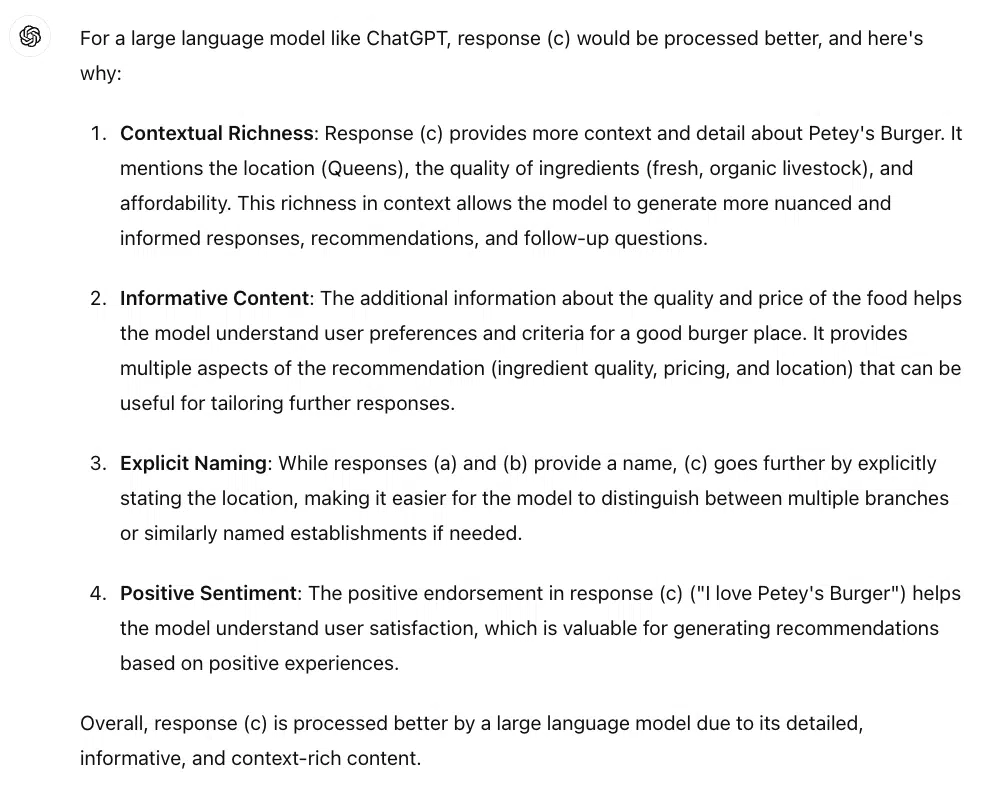Up to 94% of customers say that a negative review or social media comment has convinced them to avoid a company, according to an InMoment study.
But it’s actually much worse than that today.
Negative reviews only used to impact the person finding them. With AI taking over more and more platforms being used, all content on the web is now fair game to be used as a training source for generative AI responses.
In this article, you will learn:
- Why focusing your online efforts on one channel is no longer enough.
- How to know which platforms to focus on.
- A practical strategy for omnipresence.
‘Double down on one channel’ is really bad advice in 2024
Brands are often overwhelmed by the amount of different platforms they should be working on: Instagram, Facebook, YouTube, TikTok and Pinterest, just to name a few.
The most common pragmatic advice out there used to be to pick one and get really good at it.
As a result, many brands picked Instagram or YouTube, for instance, and doubled down on them. Some of them even managed to create a huge following on their preferred channel and were able to skyrocket their business.
Enter ChatGPT, leading the movement of generative AI.
Large language models (LLM) like OpenAI’s ChatGPT or Google’s Gemini generate answers because they have been trained on masses of content.
The better the training material, the better the answers.
LLMs are keen on getting high-quality training material and are using the web for that.
And guess what?
They are not selecting just one channel!
Everything is fair game to use as training material
Blog posts, X posts, YouTube descriptions or Pinterest posts – everything is suddenly a potential piece of content that might be used as training material for a large language model:
- When you ask Gemini how to fix a flat tire, you might be getting instructions that are based on numerous pieces of content – among them, a description of a YouTube video.
- When ChatGPT is asked about the best bookkeeping software, the answer might be based on a highly upvoted thread on Reddit.
- When a potential client has second thoughts about a coach before buying their program and asks Anthropic’s LLM Claude if a coach is a scammer, the answer might go back to an ex-employee’s review on glassdoor.com
User behavior has changed dramatically, making it impossible for brands to stay focused on just one channel and ignore the rest.
AI does not pick a channel.
You can’t be on all platforms – or can you?
Based on AI picking potentially numerous platforms at once, brands might feel overwhelmed and be tempted to ignore what’s happening right now.
You can’t possibly work your marketing across all channels at the same time, can you?
However, this might not even be necessary.
LLMs need context to generate an answer.
They also need to comprehend entities in order to build their knowledge graph.
By figuring out where the action happens for your audience, the vast majority of brands will be able to narrow it down to approximately five different platforms.
A SaaS business, for example, might find its audience mostly on Facebook, YouTube, X, Reddit and Quora.
At the same time, an art gallery might find its audience mostly on Instagram, Pinterest, YouTube, Reddit and Behance (but they might not have thought Reddit was to be considered).
The first step in order to completely understand where the focus should lie is in-depth audience-platform research.
Dig deeper: How to navigate SEO in a multi-platform world
Research your audience – for real, this time!
When talking to clients about their customers, many will tell me how they defined their client persona: their age, whether they are married, where they go on vacation and their potential political orientation.
Persona definitions are an important part of marketing and greatly help your brand’s messaging, design, ad creatives and more.
However, persona definitions seem to have little practical value for modern search and content marketing, as well as online reputation management.
Unless they are tied to a platform!
Instead of pure audience research, you need to cross-reference their platforms of choice.
Only this way, you will find critical information such as:
- How your audience describes themselves and their goals and desires.
- Where they like to hang out online.
- What kind of content they want to consume on those platforms.
Large language models will use different platforms for different parts of their training.
Once you really get to know your audience and the platforms they are using, it’s time to get your brand “out there” across those platforms as efficiently as possible.
Dig deeper: An SEO guide to audience research and content analysis
The three-tier approach to leveraging the most important platforms
Hardly any brand will have the resources and experience to fully exploit all possibilities on every platform.
To enable cross-platform SEO, here is a practical three-tier approach that specifies three levels of focus and intensity to centralize resources where they will have the most impact on human potential clients and AI.
Tier 1: Full engagement
Based on your audience-platform research, the top five platforms can be seen as Tier 1 platforms. This is where your audience hangs out the most. Here, your consistent brand presence and engagement will have the highest long-term impact.
By actively creating specific content for your brand on Tier 1 platforms, you will position yourself as a thought leader in your industry. This will not only shape the quality of leads you get but also have a positive impact on your conversion rate.
These days, many brands will find Reddit and YouTube within their top 5 platforms.
These two platforms especially make sense as Reddit is partnering with Google and OpenAI and YouTube is part of the Alphabet family.
Research has shown that the priority of Instagram, X, Pinterest or Quora will greatly vary depending on your niche and competitors’ activity levels.
Some industries’ audiences are really keen on getting a lot of orientation, so they ask a lot of questions.
In other industries, people appreciate more inspirational or educational content.
The former might find Quora to be a Tier 1 platform, the latter might see Instagram towards the top.
Strategy: Set your brand up for cross-platform success by creating engaging content on your most important platforms and participating as a branded account in relevant discussions and comment threads.
Tier 2: Product-service branding
While the top 5 platforms should be used to actively shape the conversation, this doesn’t mean that other platforms less frequented by your audience should be ignored. A broader setup, with mentions and engagement across a variety of platforms, will showcase your brand’s relevance and popularity.
For a lot of brands, X might not come across as a Tier 1 platform.
However, in generative AI tests on different tools, X posts seem to often be a very likely source of training material to generate certain answers. This seems to be especially the case when they refer to a personal or business brand’s account.
As a result, a strategy can be to leverage Tier 2 platforms to provide users and AI tools with contextual information related to your brand or products:
- The costs of your product.
- Alternatives for a particular product.
- Times to deliver a particular service.
- Customer service details.
- Common issues that have an easy solution.
- And more.
In addition, specifically for platforms like X, short context-rich messages about the brand, product or ideal client profile (ICP) will semantically link the brand to the most important entities, as well as product applications and pricing levels.
Strategy: Start by leveraging Tier 2 platforms for frequently publishing context-rich content about your brand and products or services and answer specific directed questions on a regular basis.
Tier 3: Related websites
Tier 3 is all about websites that are topically related to your space and ideally have some sort of authority or resource status.
For example, Search Engine Land is a site that’s highly relevant for anybody working in search marketing. However, if you are a professional coach, collaborating with the International Coaching Federation (ICF) will be highly beneficial for your brand’s entity.
Apart from authority websites, you might also consider working with platforms like medium.com, tumblr.com, soundcloud.com or substack.com, employing a minimum effort there but still establishing a context-rich brand presence.
Strategy: Aim to collaborate with at least 3-5 authority websites in your industry by contributing content, participating in discussions, sponsoring events, link building, brand mentions, etc.
Also, try to repurpose content and push it through some of the smaller platforms.
What you write about provides the context
One thing that is easy to miss when working on a platform is that your answer or comment might not only be for the person reading it.
It is also potential training material for an LLM and can only be taken into account if it contains proper context, entities and simple structure.
Imagine someone posting the following message on “X”:
- “Can anybody recommend a good NY burger place?”
- Responses might be:
- a. “Harlem Shake at 100W 124th St.”
- b. “You definitely have to try Petey’s Burger.”
- c. “I love Petey’s Burger in Queens! They always use fresh ingredients, their prices are affordable and their meat comes from organic livestock.”
Although LLMs won’t care about anybody’s favorite food choice, they will surely get more context for training from option C.
Or, as ChatGPT would explain it:

Strategy: Your contributions (whether new content or comments on existing content pieces) must be valuable and rich in relevant context.
Efficient management of multiple platforms
An actionable strategy in order to properly work the top 5 platform can entail things like:
- Assigning different platforms to different members of your team.
- Dedicating specific time slots in team members’ agendas to working on specific platforms.
- Setting up alerts (eg., via Google Alerts) notifying the team about conversations relevant to the brand that might make for an interesting interaction.
- Developing SOPs (standard operating procedures) on how to handle positive and negative brand feedback – and how to achieve a name drop or brand mention.
As so often with SEO and online reputation management, it all comes down to defining and consistently executing a proper process.
Context-rich online reputation across all platforms that matter
The more context you provide on important platforms, the more you will notice actual clients engaging with your brand.
At the same time, you increase the likelihood of AI platforms from Google, OpenAI or others picking up on your contributions and using them as training material about your topics and brand.
Dig deeper: Search everywhere optimization: 7 platforms SEOs need to optimize for beyond Google
Contributing authors are invited to create content for Search Engine Land and are chosen for their expertise and contribution to the search community. Our contributors work under the oversight of the editorial staff and contributions are checked for quality and relevance to our readers. The opinions they express are their own.




